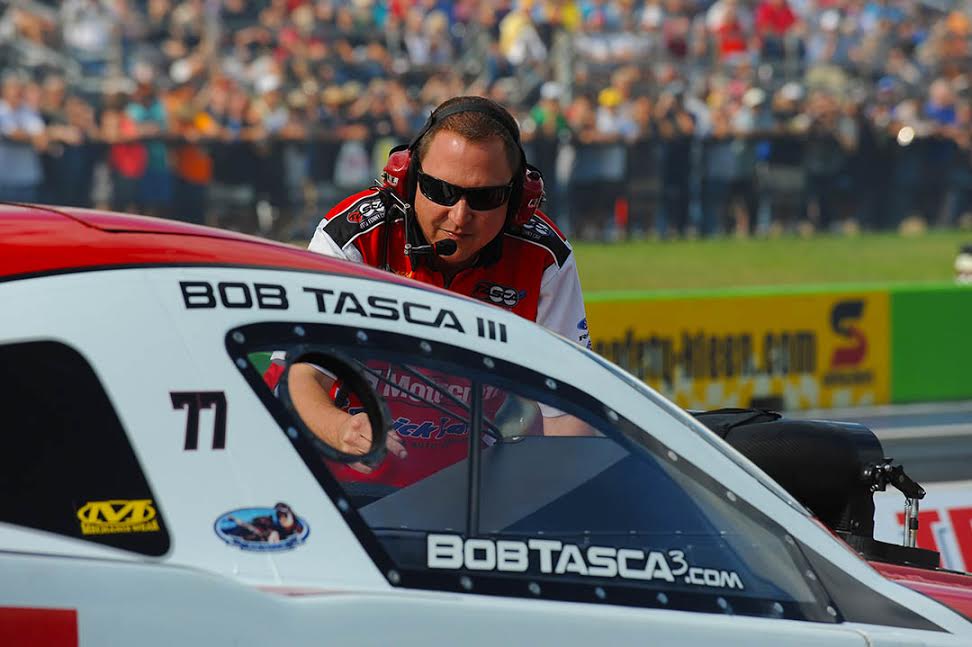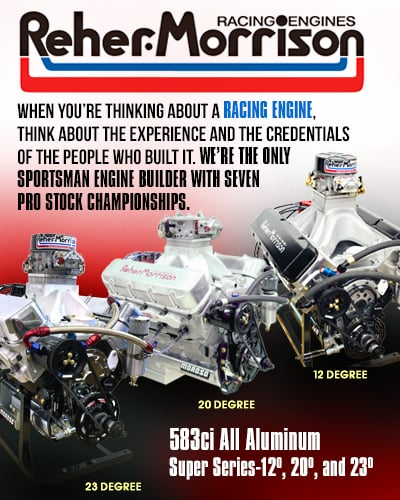CREW CHIEF DENNER MANAGES PEOPLE, PARTS, CAR AND WEATHER ON TYPICAL RACE WEEKEND
 One might not expect an NHRA crew chief to be an amateur meteorologist, but the weather plays such a big role in how a nitro hot rod is set up that the first thing Motorcraft/Quick Lane Ford Shelby Mustang Funny Car crew chief Marc Denner does each day his car is running is check the weather.
One might not expect an NHRA crew chief to be an amateur meteorologist, but the weather plays such a big role in how a nitro hot rod is set up that the first thing Motorcraft/Quick Lane Ford Shelby Mustang Funny Car crew chief Marc Denner does each day his car is running is check the weather.
“Weather affects everything,” said Denner, who was co-crew chief on Bob Tasca III’s Funny Car from 2009 until midway through this season when he became the sole crew chief.
One might not expect an NHRA crew chief to be an amateur meteorologist, but the weather plays such a big role in how a nitro hot rod is set up that the first thing Motorcraft/Quick Lane Ford Shelby Mustang Funny Car crew chief Marc Denner does each day his car is running is check the weather.
“Weather affects everything,” said Denner, who was co-crew chief on Bob Tasca III’s Funny Car from 2009 until midway through this season when he became the sole crew chief.
 Air temperature determines what thickness gaskets should be and how fast the supercharger or blower needs to spin to generate the right amount of power to get the car down the track in about 4 seconds. Track temperature influences clutch settings and tire size and pressure decisions that, if all goes well, transfers 10,000 horsepower to the track and gets the car to the finish line without losing traction.
Air temperature determines what thickness gaskets should be and how fast the supercharger or blower needs to spin to generate the right amount of power to get the car down the track in about 4 seconds. Track temperature influences clutch settings and tire size and pressure decisions that, if all goes well, transfers 10,000 horsepower to the track and gets the car to the finish line without losing traction.
“It’s unparalleled in sports the amount of responsibility the crew chief holds,” said Tasca about the importance of an NHRA crew chief. “At the end of the day, a great driver in a crappy car is a crappy driver. An average driver in a great car is a great driver. The decisions the crew chief makes determines what happens on the track.”
Denner came by his interest in drag racing naturally as his father was a regional Top Fuel racer in the Midwest for almost 30 years. “The whole time I was growing up there was a Top Fuel car in the garage,” he recalled. “We never went on vacation. We went racing. We didn’t have a sponsor. We did it mostly for fun.”
His first taste of big-time racing came as a 20-year-old in the mid-1990s when he worked on cylinder heads for a low-budget team in return for room and board. “I got a paycheck about every six months,” he said.
From there he worked on rods and pistons for Del Worsham in 1997, then the clutch in ’98. From 2003-2008, he became co-crew chief with Chris Cunningham on another car in the Worsham stable. He worked on Worsham’s car again in 2008 and when he switched teams for the 2009 season, the Cunningham-Denner team joined Team Tasca. The pair worked together until this past May when Cunningham was given his release, handing full control of the Motorcraft/Quick Lane Funny Car to Denner.
As the sole crew chief of the Ford Shelby Mustang, Denner’s work begins long before the haulers show up in the pit area on the Thursday before a race weekend. “He’s got to be an innovator and a logistical guy, getting stuff around the country,” Tasca explained. “People have no idea what goes into feeding the inventory of these cars especially when you have three or four races in a row.”
Denner said before he leaves a race for the next week’s action, he gets a list of all the parts his crew members will need for the following week, or weeks depending on the schedule.
“I make that list and fly home on Monday morning and go to the shop,” Denner said. “If the guys are coming to the shop, I make a list of everything that has to be done at the shop with the car, the truck, the trailer, the shop and put it on a board so everyone can see it. I’ll order parts Monday, Tuesday and Wednesday to get everything to the shop by the time we leave for the next race.”
If it’s a week with no race, “Thursday and Friday, we might get a chance to work on the car a little bit, put the blower and clutch discs on the dynamometer,” he said. “If there’s no race we’ll take Saturday and Sunday off, maybe Monday if we’re going into a long stretch of races. I’ll go in Monday anyway and finish up ordering any parts that might need to be sent to the track to get that timing right. Jump back on the plane and go to the next race.”
Once at the track, the weather watch, as well as a frenzy of other activities, begins.
 “On Thursday at the track, I turn the weather station on to see what the weather is doing and see what the tune up will be for the next day,” Denner said. “I’ll walk the track, both lanes up and down once or twice to see how thick the rubber is, how much they scraped it and look for bumps. You’re checking to see how far the concrete extends past the starting line. It’s different with every track and changes the way you’re going to run the car.
“On Thursday at the track, I turn the weather station on to see what the weather is doing and see what the tune up will be for the next day,” Denner said. “I’ll walk the track, both lanes up and down once or twice to see how thick the rubber is, how much they scraped it and look for bumps. You’re checking to see how far the concrete extends past the starting line. It’s different with every track and changes the way you’re going to run the car.
“We wrap up on Thursday at about 4 or 5 o’clock and then we get a decent dinner because you know that’s the last one you’re going to get,” he said.
“On Friday, I come in and turn on the weather station and start figuring out the gaskets for the day,” Denner explained. “Weather affects gaskets, blower and everything really. We have a track temperature indicator in the hauler that’s pretty accurate so you can start making your calls on the clutch and floater (disc) package. You make all of those calls before you even warm up. We decide on tire size and whether to mount used or new tires. We have changed tires in the staging lane before but that’s an extreme situation.”
The Motorcraft/Quick Lane Funny Car crew chief said it’s important that the car makes a solid run in the first Friday qualifying session so you have a solid foundation on which to build the rest of the weekend’s runs. “Hopefully you get down the track because that gives you a baseline and a good jumping off point for the rest of the weekend,” he said. “You make your run Friday night and hopefully you’re in the top 12 so you don’t have to sweat Saturday trying to qualify in the heat.”
If a team’s car is firmly in the field at close of business on Friday, it can use the Saturday qualifying runs to prepare for race day, according to Denner. “If you’re in the race solidly you might want to test something on Saturday afternoon because it’s usually the hottest one of the day,” he said.
 “On Saturday night, you get four runs worth of parts and equipment ready for Sunday,” Denner said. “On Sunday, you look at the weather again and make all those calls depending on who you’re racing.”
“On Saturday night, you get four runs worth of parts and equipment ready for Sunday,” Denner said. “On Sunday, you look at the weather again and make all those calls depending on who you’re racing.”
One of the many complex decisions crew chiefs make every time their cars run is selecting a clutch package. “You start the year with 600 clutch discs,” Denner explains. “They come from different batches. You can’t run all five discs from the same batch or the car will never get down the track. They all have different torque curves. You try to make a torque curve that works for you. That only works for 150 runs. So you’re always looking ahead 50 runs to see what you want to do then.”
When asked if he keeps a book on how to set up the car for a particular track based on past success, Denner said, “We keep a book, run to run. You’re always working off your last run. Setup charts are only good for about a month. Everything from last year you can just throw out. It evolves at such a pace that you can’t look back.”
Regardless if the final run of the day ends in victory lane or in disappointment, when the car gets back to the pit, everything gets packed up and the process starts all over.
Tasca said his relationship with his crew chief is different than other drivers since he also owns the Motorcraft/Quick Lane team.
“As an owner/driver, I’m in constant communication with the crew chief whereas if I was just a driver, I’d bring my helmet, hop in the car and drive and go home,” Tasca said. “It is a very different dynamic being an owner/driver.”
According to Tasca, a crew chief has three main responsibilities and that all three are equally critical.
“One is win,” he said. “Two is to make sure you don’t bankrupt the team because engines are $100,000 apiece and you can blow up engines really easy if you don’t know what you’re doing. Third, and probably most important of all, is bringing the driver back safely.
“The crew chief has to make sure he’s got the right people on the car and that the car is bolted together,” he said. “He also has to make sure that there’s a tune-up in the car that’s capable of winning yet not set the driver on fire every time down the track.
“Obviously you can’t control the uncontrollable,” Tasca continued. “You’re still sitting in a 10,000-horsepower bomb. Winning is very important but having the money to run a car is very important, too, and keeping the driver and crew safe is pretty damned important.”




































